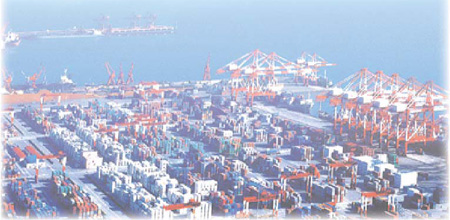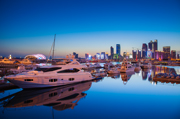President gives blessing to new 'blue' marine economy initiative
By Chen Weihong ( China Daily )
Updated: 2009-07-14
|
|||||||||
|
Qingdao Port: the largest container port in the world. |
During his inspection tour of Shandong province earlier this year, President Hu Jintao underlined the commitment to the economic development of the region.
Addressing officials during his visit, he said: "We will vigorously develop the marine economy, scientifically develop marine resources, cultivate competitive marine industries and build a 'blue' Shandong Peninsula Economic Zone."
This strategic goal represents an enormous development opportunity for Shandong. Over recent months, a number of senior government officials, including Jiang Yikang, secretary of the CPC Shandong Provincial Committee, and Jiang Daming, governor of Shandong, have visited the Shandong Peninsula and conferred with economic experts over plans for its development.
With regard to the Peninsula's future, Jiang Yikang said: "Shandong is uniquely positioned to develop a 'blue' economy and will not hesitate to seize this historic opportunity to boost its marine capabilities."
Facing the Korean Peninsula and the Japanese islands across the sea, and situated at the key junction of the Bohai Rim region and the Northeast Asia Economic Circle, the Shandong Peninsula offers the most convenient access to the sea along the Yellow River. Its coastline, bay area, and marine resources are all among the most highly regarded China has to offer. It also has access to some of the country's leading marine technology experts
Its strong economic ties with Japan, the Republic of Korea, Russia and the Far East area also put it in an ideal position to ensure international economic cooperation.
Blueprint
According to local government plans, the economic zone will benefit from a total investment of 1.4 trillion yuan by 2020 and result in the formation of nine individual industrial districts. These nine core districts will include the Dingzi Bay New City, the Weifang New City and the Dongying Cluster of Petroleum Industries.
Considerable importance will be attached to nurturing industries with unique advantages or particular competitiveness. These will include industrial clusters such as shipping, ship-building, marine chemicals, heavy chemical equipment manufacturing, marine tourism, marine biology, high-tech marine industries, offshore oil and gas exploration, and new marine energy.
Cai Limin, vice-governor of Shandong, said: "The implementation of this important strategy will make Shandong a vital access point between northeast China and the Yangtze River Delta Economic Zone.
"Shandong will also play a more important role in the Bohai Rim Economic Circle and a pilot free trade zone between China, Japan and South Korea."
The significance of the development was echoed by Hou Yingmin, director-general of the provincial Department of Oceans and Fisheries: "The zone will make Shandong a high-end marine manufacturing industrial center, a high-tech marine research and development center and the internal shipping center for northeast Asia."
As a coastal province, Shandong has a coastline of more than 3,000 km, one sixth of the nation's total, and features some 200 harbors. Its marine industry is listed as the number one in China, with its marine production value standing at 534.6 billion yuan, accounting for 18 percent of nationwide total last year.
According to government statistics, more than 100 ocean-going ships have now been manufactured in Shandong for both domestic and global customers. Ship-building factories in the province are currently in receipt of more than 60 billion yuan worth of orders. It is anticipated that every shipyard in the province will be operating at full capacity by the end of 2010.
(China Daily 07/14/2009 page24)




